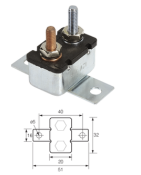bpratt
Senior elf
Here's an interesting topic/question.
Why don't we use self resetting automotive circuit breakers instead of fuses in our lighting displays ?
I'm guessing it is because they are a lot more expensive than a ATO fuse.
Also one would assume that if you had an issue to blow a fuse/trip a circuit breaker, you probably wouldn't want power to be constantly reapplied to it.
Of course most boards are already fitted with a ATO fuse holder, but power to the boards can be fitted with either.
I didn't see a topic on this, but thought having a topic discussing automotive circuit breakers replacing fuses might be a useful thread for those who might consider using circuit breaker instead of fuses.
Why don't we use self resetting automotive circuit breakers instead of fuses in our lighting displays ?
I'm guessing it is because they are a lot more expensive than a ATO fuse.
Also one would assume that if you had an issue to blow a fuse/trip a circuit breaker, you probably wouldn't want power to be constantly reapplied to it.
Of course most boards are already fitted with a ATO fuse holder, but power to the boards can be fitted with either.
I didn't see a topic on this, but thought having a topic discussing automotive circuit breakers replacing fuses might be a useful thread for those who might consider using circuit breaker instead of fuses.


